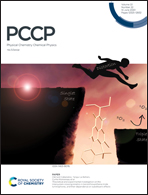Interfacial properties of binary mixtures of simple fluids and their relation to the phase diagram†
Abstract
Interfacial properties of binary fluid mixtures were studied using both molecular dynamics (MD) simulations and density gradient theory (DGT). The focus of the study is on the relation of the interfacial properties to the phase diagram of the mixture. Two binary Lennard-Jones mixtures were investigated in a wide range of states: a highly asymmetric mixture (type III), which exhibits vapour–liquid equilibria (VL1E and VL2E), liquid–liquid equilibria (L1L2E), a three-phase equilibrium (VL1L2E), and supercritical fluid–fluid equilibria (F1F2E), and, as a reference, an ideal mixture (type I). The studied interfacial properties are: the surface tension, the relative adsorption, the width of the interfacial region, and the enrichment of the low-boiling component, on which we set a focus. Enrichment was observed at VL1 interfaces; and, to a small extent, also at L1L2 interfaces; but not at the supercritical F1F2 interfaces. The large enrichment found at VL1 interfaces of the type III mixture can be interpreted as a wetting transition: approaching the VL1L2E three-phase line from the VL1 side, the enrichment gets stronger and can be interpreted as precursor of the second liquid phase L2. However, the actual existence of a three-phase line in the phase diagram is no prerequisite for an enrichment. The enrichment is found to be highly temperature-dependent and increases with decreasing temperature.



 Please wait while we load your content...
Please wait while we load your content...